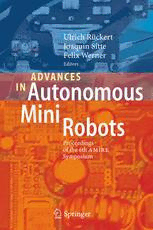
Advances in Autonomous Mini Robots: Proceedings of the 6-th AMiRE Symposium PDF
Preview Advances in Autonomous Mini Robots: Proceedings of the 6-th AMiRE Symposium
Advances in Autonomous Mini Robots Ulrich Rückert, Joaquin Sitte, and Felix Werner (Eds.) Advances in Autonomous Mini Robots Proceedings of the 6th AMiRE Symposium ABC Editors Prof.Dr.UlrichRückert Dr.FelixWerner CognitiveInteractionTechnology CognitiveInteractionTechnology CentreofExcellence CentreofExcellence CognitronicsandSensorSystems CognitronicsandSensorSystems Bielefeld Bielefeld Germany Germany Dr.JoaquinSitte QueenslandUniversityofTechnology FacultyofScienceandEngineering Brisbane Queensland Australia ISBN978-3-642-27481-7 e-ISBN978-3-642-27482-4 DOI10.1007/978-3-642-27482-4 SpringerHeidelbergNewYorkDordrechtLondon LibraryofCongressControlNumber:2012930481 (cid:2)c Springer-VerlagBerlinHeidelberg2012 Thisworkissubjecttocopyright.AllrightsarereservedbythePublisher,whetherthewholeorpartof thematerialisconcerned,specificallytherightsoftranslation,reprinting,reuseofillustrations,recitation, broadcasting,reproductiononmicrofilmsorinanyotherphysicalway,andtransmissionorinformation storageandretrieval,electronicadaptation,computersoftware,orbysimilarordissimilarmethodology nowknownorhereafterdeveloped.Exemptedfromthislegalreservationarebriefexcerptsinconnection with reviews or scholarly analysis or material supplied specifically for the purpose of being entered and executed on a computer system, for exclusive use by the purchaser of the work. Duplication of this publication or parts thereof is permitted only under the provisions of the Copyright Law of the Publisher’slocation,initscurrentversion,andpermissionforusemustalwaysbeobtainedfromSpringer. PermissionsforusemaybeobtainedthroughRightsLinkattheCopyrightClearanceCenter.Violations areliabletoprosecutionundertherespectiveCopyrightLaw. Theuseofgeneraldescriptivenames,registerednames,trademarks,servicemarks,etc.inthispublication doesnotimply,evenintheabsenceofaspecificstatement,thatsuchnamesareexemptfromtherelevant protectivelawsandregulationsandthereforefreeforgeneraluse. Whiletheadviceandinformationinthisbookarebelievedtobetrueandaccurateatthedateofpub- lication,neithertheauthorsnortheeditorsnorthepublishercanacceptanylegalresponsibilityforany errorsoromissionsthatmaybemade.Thepublishermakesnowarranty,expressorimplied,withrespect tothematerialcontainedherein. Printedonacid-freepaper SpringerispartofSpringerScience+BusinessMedia(www.springer.com) Preface Ten Years of AMiRE Symposia Introduction Withthisvolume,containingtheextendedcontributionstothe6-thAMiRESympo- siumwecelebratethe10-thanniversaryoftheAMiREsymposiumseries(amiresym- posia.org).Allcontributedpapershavebeenrigorouslypeerreviewed.Wethankthe authorsandthereviewersfortheirworkthatmadethisvolumepossible. Before introducingthe articles in this volume we wish to share with you some reflectionsonthemotivationsfortheAMiRESymposiaandthecontributionsthey mayhavemadetotheadvancementofthefieldofautonomousrobotics. ThefirstInternationalSymposiumonAutonomousMinirobotsforResearchand Edutainment(AMiRE)washeldin2001attheHeinzNixdorfInstituteoftheUni- versityofPaderborn,Germany.Ourmotivationtocallthissymposiumwastopro- motetheuseofminirobotsasatoolforresearchanddevelopmentofautonomous machine technology. We wanted to assist in giving recognition and legitimacy to researchersthatweredesigningandusingsmallsizeandinexpensiverobotstode- velop ingenioustechnicalsolutions to make substantive research contributions.In 2001 robot soccer tournaments were only a few years old and the Khepera robot hadjustgrabbedafootholdinthemarketasthequintessentialminirobot.Theim- pactontheinitialobjectiveoftherapidtechnologydevelopmentwasreportedinthe AMiRE Symposia that followed in 2003 (Brisbane), 2005 (Fukui), 2007 (Buenos Aires)and2009Incheon. Thequestionthatinevitablycomesupis:Howsmalldoesa robothavetobeto becalledaminirobot.Obviously,itdoesnotmakesensetogiveastrictsizelimit. Instead, we have gradually arrivedat the following conditionsthat a robotshould meet to qualify as mini. The first criterion is that it must be suitable for desktop experimentation.Here,theworddesktopisgivenabroadmeaningasitmayextend toalargetable,thefloorofanoffice,alivingroomorasmalllaboratory.Thisalso meansthataminirobotcanbecarriedaroundeasily.Thenextcriterioniscost.The robots must be affordableto schools and university departments. Ideally, students andhobbyistshouldbeabletoaffordthem.Takingwellknownrobotsasexamples, the Sony Aibo robot is near the top of the mini scale and the Alice robot is near VI Preface the bottom of the scale. Critics may say that in this size and cost range you can onlyhavetoys,withverylimitedcapabilitiesforresearchandeveneducation.The work presentedby researchersat the variousAMiRE Symposiaeasily refutesthis criticism.In2001itwastruethattheavailablemicroelectronictechnologywasnot fully exploited by the mini robots of the time, and it remains true today. It is one of the AMiRE symposium goals to promote the full exploitation of the available electronics, sensor and actuator technologyfor making highly capable robots in a smallbodyatalowcost. Anotherargumentagainstminirobotshasbeenthatforrobotstobeusefulthey mustbecommensuratewiththescaleofthingsinthehumanenvironment.Itistrue that a mini robot, as defined above, will not be able to open the door for a frail elderlypersonnorunloadthegroceriesfromyourcar.However,therequiredcogni- tivecapabilitiesandphysicaldexterityrequiredforperforminghelpfultasksarenot specifictosize.Iftheworldwasshrunktomatchthesizeofthedoor,thegroceries orthecartotheminirobottherequiredcognitiveabilitiesandthedexteritywould remainthesamefortheminirobotasforthelargerrobotmatchedtoahumanscale environment.Usefulrobotbehavioursthatworkattheminiscalecanbescaled-up inmostcasestothedesiredscale. Minirobotsin2001weremainlypoweredby16bitprocessors.Todayitispos- sible to have several 32 bit microprocessors on a mini robot in addition to a full fledgedCPUforsubstantialnumbercrunchingwithhundredsofmegabytesofmem- ory,ifnotGigabytes.Thankstotheenormousgrowthofthemobilephonemarket wirelesscommunicationisubiquitousandcheap,andsoaredigitalimagesensors. Thestageissetforabigjumpinthecapabilitiesofminirobots.Thecontributions inthisvolumeprovideplentyofinspiration. ArticlePreviews Three,attimesoverlappingthemesstoodoutatAMiRE2011: • Roboticsforeducation • Workbenchesformulti-robotexperimentation • Newwalking,flyingandbalancingrobotplatformsthatmakeinnovativeuseof off-the-shelfsensingdevices. In addition to the contributed papers we were fortunate to host four outstanding keynotelecturers.EducationalroboticswasopenedbyPaoloDario’skeynotelecture on Bioinspired Minirobotic Platforms for Educational Activities, that highlighted the remarkable work in progress at the BioRobotics Institute of Scuola Superiore SantAnnaintheLocalEducationalLaboratoryonRoboticsprograme.Inthispro- gram activities in robotic are not limited to teaching in science, engineering and mathematics,butalsoinliterature,arts,popularculture,philosophyandsociology, andculturalstudies.BioroboticswasalsothethemeofRogerQuinn’skeynotelec- ture on Animals as models for robot mobility and autonomy: Crawling, walking, running,climbingandflying.InsigthsintothewinningstrategiesforRoboCuprobot soccerwererevealedbyManuelaVelosoinherkeynotelectureonTeamworkPlan- ning in Adversial Multi-Robot Domains. Non-adversialcooperation of robots and Preface VII humanswasthefocusofNaoyukiKubota’skeynotelectureonLearningandAdap- tationforHuman-friendlyRobotPartnersinInformationallyStructuredSpaces.The contentofthislectureisfoundinthepaperofthesametitleinthisvolume. The presentation of contributed papers started with Teaching with mini robots: TheLocalEducationalLaboratoryonRoboticsbySalvinietal.,wheremembersof PaoloDarios’sBioRoboticsInstitutereportontheremarkableroboticsprogramfor primaryandsecondaryschoolsoftheValderaregionofTuscany,Italy. InAtwoyearsinformallearningexperienceusingtheThymiorobotRiedoetal. tellwhatworkedandwhatdidn’tinaroboticsworkshopforchildrenattheyearly roboticsfestivalatEPFLusingapurposedesignedinexpensiverobotkit. Gonzalez-Gomezet al. show the educationalpotentialof the new worldof low cost3Dprinting,whereeveryonecanprintitsownrobotparts,inNewOpenSource 3D-printableMobileRoboticPlatformforEducation. Uribeetal.inGermanLaRA:AnAutonomousRobotPlatformSupportedbyan EducationalMethodologydescribeandevaluateadeeplearningapproachforteach- ing robotics to tertiary students practised at the Tecnolo´gico de Monterrey, Cuer- navaca,Mexico. InMutualLearningforSecondLanguageEducationandLanguageAcquisition ofRobots,YoritaandKubotadescribetheirwayofassistingEnglishlanguagelearn- ingforJapanesespeakersusingrobotsaspartnerswhereboththepupilandtherobot learnfromeachother. Variouskindsofsmalllowcosttoyhelicoptershavebecomecommerciallyavail- abeinrecentyears.Pradalieretal.fromtheETH(SwissFederalInstituteofTech- nology)inZurichhavetakenthistechnologyastepfurtherwhentheyreportonThe CoaX micro-helicopter:a flying platform for educationand research packed with sensorsthatcanbeboughtfromSkyboticsinSwitzerland. Also packed with processingpower is the AMiRo AutonomousMiniRobotfor research and education described Herbrechtsmeier et al. This is a small wheeled robot designed for the vision based, fully autonomous AMiRESot soccer tourna- ment.The robotisbased ona completesetof electronicmodulesthatcan also be usedforrobotsofotherphysicalconfigurations.TetzlaffandWitkowskialsoreport onalowbudgetconstructionofarobotforAMiRESotthroughcarefullymanaged studentprojectsin ModularRobotPlatform for TeachingDigitalHardware Engi- neeringandforPlayingRobotSoccerintheAMiREsotLeague.Theirtwo-wheeled differentially steered robot does not need castors because it can move while bal- ancing on its two wheels. Witkowski and his students also presentthe first Radar SensorImplementationintoaSmallAutonomousVehicle. MinirobotsforresearchareexemplifiedinThewandarobotanditsdevelopment system for swarm algorithms. In their work Kettler et al. present the 51 mm di- ameterlowcost,yetpowerful,robotaimedatinvestigatingswarmalgorithmswith many tens, or even a hundred, of these robots. They also developed truthful sim- ulation software for the robot and an experimentation arena for analysing swarm behaviours. AnupscalearenaforMulti-RobotSystemValidation:FromsimulationtoProto- typingwith Minirobotsin theTeleworkbenchisdescribedTanotoetal.Ina 4mby VIII Preface 4mareatheTeleworkbenchcancaptureandevaluatethevideorecordofmultirobot experimentsfrom severalcamerassimultaneously.Di Paola et al. describeAn Ex- perimentalTestbedforRoboticNetwork Applicationsthatisa smallscaleandlow costarena with associatedsoftware formultirobotexperimentationusing Khepera II,E-PuckandLegoNTXrobots. Demandingvisiontaskssuchasrealtimeobjectrecognitionandvisualnaviga- tion are now within reach of mini robots thanks to ingenious use of off-the-shelf hardware. Hafiz and Murase show in their paper iRov: A Robot Platform for Ac- tive Vision Research and as Education Tool how to combine the iPhone cameras with special optics to obtain panoramic, peripheraland foveal vision and achieve realtime objectrecognition.Langeetal. reportinAutonomousCorridorFlightof a UAV Using a Low-Cost and Light-Weight RGB-D Camera how they obtain the 3Dstructureofanindoorenvironmentforautonomousnavigationofaquad-copter withthelowcostMicrosoftKinectsensor. Thefollowingtwopapersaddresstheimportanttopicofselectiveattention.Maire etal.describeamethodforSegmentationofScenesofMobileObjectsandDemon- strableBackgroundsusefulforselectiveattentioninrobotvision. InAReal-TimeEvent-BasedSelectiveAttentionSystemforActiveVisionSonnlei- thnerandIndiveridescribeavisionsystemusingspikingneuronsonVLSIchipsfor theextremelyfastlocalisationofregionsofchangeinthevisualfield. There are several examples of ingenuous use of small robots as a tool for re- searchinotherscienceandengineeringfields.InTheARUMExperimentationPlat- form :an ”Open”Toolto evaluateMobileSystemsApplicationsSeveracandRoy reportonusingrobotsascarriersofwirelesscommunicationunitsinalargearena to investigate the performance of mobile wireless networks in controlled realistic experiments. Very uniqueis theidea of RiedenklauandPetke on EmbodiedSocialNetwork- ing with Gesture-enabledTangible Active Objectsof using simple small robotsas mobiletangibleobjectsforexploringnewmodalitiesinhumancomputerinterfaces. Robotsare also a research toolforbiologicalstudies. Schneideretal. designed andbuiltHECTOR,aNewHexapodRobotPlatformwithIncreasedMobility-De- signandCommunicationasatoolforresearchintoinsectwalkingandalsoforbio- logicallyinspiredlocomotionforrobots.Itisknownthatinsectslegscooperatewith ahighdegreeofautonomytoproduceefficientwalkinggaits.ThedesignofHector incorporatesthis idea and others from the extensive knowledge of insect walking accumulated by researchers at Bielefeld University. Unlike other walking robots, Hectorhasanelastic elementbuiltintoeachof the eighteenjointsforobtaininga compliantdynamicbehavioursimilartotheactionofmuscles. A pureengineeringapproachtocooperativewalkingbyautonomouslegsisde- scribedbyDeSilvaandSitteinForceControlledHexapodWalkingwhereelasticity isobtainedbypositionandcontactforcefeedbackcontrol. Preface IX ConclusionandAcknowledgements Thepapersinthisvolumereflectthe state-of-the-artofminiroboticsresearchand technology and surely will make useful reading for anyone with an interested in thisfield.LastbutnotleastwewishtothanktheCognitiveInteractionTechnology Excellence Centre (CITEC), funded by the German Research Foundation (DFG), andtheCentreforInterdisciplinaryResearch(ZIF)ofBielefeldUniversityfortheir financialandmaterialcontributiontothesuccessofthishighlyproductivemeeting. UlrichRu¨ckert JoaquinSitte AMiRE2011Co-chairs AMiRE 2011 Organisation General Co-chairs UlrichRu¨ckert BielefeldUniversity,Germany JoaquinSitte QueenslandUniversityofTechnology,Australia AdvisoryBoard IllahNourbakhsh CarnegieMellonUniversity,USA NaoyukiKubota TokyoMetropolitanUniversity,Japan TuckerBalch GeorgiaInstituteofTechnology,USA FrancescoMondada SwissFederalInstituteofTechnologyZu¨rich, Switzerland Technical Co-chairs FelixWerner BielefeldUniversity,Germany UlfWitkowski SouthWestphaliaUniversityofAppliedSciences, Germany Technical Committee MichaelAngermann GermanAerospaceCenter,Germany ErikBerglund O¨rebroUniversity,Sweden ThomasBraeunl TheUniversityofWesternAustralia,Australia AnsgarBredenfeld FraunhoferInstitute,Germany GillesCaprari SwissFederalInstituteofTechnologyZu¨rich, Switzerland JeremiGancet SpaceApplicationServices,Belgium ShlomoGeva QueenslandUniversityofTechnology,Australia RobertoGuzman RobotnikAutomation,Spain XII AMiRE2011Organisation GiacomoIndiveri SwissFederalInstituteofTechnologyZu¨rich, Switzerland NarongdechKeeratipranon DhurakijPunditUniversity,Thailand FredericMaire QueenslandUniversityofTechnology,Australia LinoForteMarques UniversidadedeCoimbra,Portugal NikolaosMavridis UnitedArabEmiratesUniversity, UnitedArabEmirates DylanRichardMuir UniversityofZu¨rich,Switzerland KazuyukiMurase UniversityofFukui,Japan FiorellaOperto SchoolofRobotics,Italy JacquesPenders SheffieldHallamUniversity,UnitedKingdom FernandoRamos TecnologicodeMonterrey,Mexico AxelSchneider BielefeldUniversity,Germany SergeStinckwich Universite’deCaenBasseNormandie,France HartmutSurmann FraunhoferInstitute,Germany MattiasWahde ChalmersUniversityofTechnology,Sweden Local Organiser CordulaHeidbrede BielefeldUniversity,Germany Website PeterChrist BielefeldUniversity,Germany
